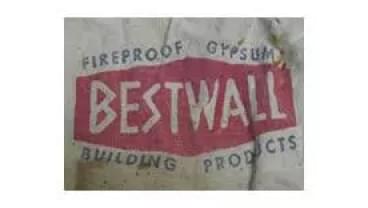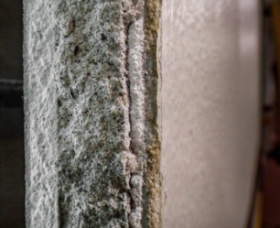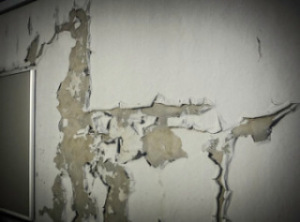Bestwall Gypsum Company
Bestwall Gypsum Company was a successful construction product manufacturer that made asbestos-containing wallboard and compounds. It faced many lawsuits that forced it to file for bankruptcy in 2017 and develop a trust fund to handle future asbestos claims.

Bestwall Gypsum’s History with Asbestos

Bestwall Gypsum Company was founded in 1956 as a spinoff of CertainTeed Corporation and was known for its signature gypsum wallboard. The company incorporated asbestos into most of its products, including gypsum wallboard and joint compounds, the latter of which workers used to fill gaps between pieces of drywall.
In 1965, Bestwall was acquired by Georgia-Pacific, and the asbestos products carried the Georgia-Pacific name thereafter. Bestwall and Georgia-Pacific products contained asbestos as a major component in joint compounds and other products from 1956 until U.S. laws mandated its discontinuation in joint compounds in 1977.
Employees of Bestwall Gypsum and Georgia-Pacific and the end users of their products encountered asbestos on a regular basis, breathing in dangerous fibers known to cause cancer such as mesothelioma.
After facing hundreds of thousands of asbestos-related lawsuits, Georgia-Pacific performed an internal corporate restructuring in the summer of 2017 and created an entity called Bestwall LLC to funnel all of its asbestos liabilities into. Several months later, Bestwall filed for Chapter 11 bankruptcy protection to establish a trust fund to handle asbestos claims.
Throughout the years of asbestos use at Bestwall and Georgia-Pacific, the company was well aware of the mineral’s adverse effects. Executives at Bestwall and Georgia-Pacific failed to disclose the information to employees or consumers, and they even created a secret program that falsified research to undermine asbestos claims filed against them.
Georgia-Pacific Falsified Research to Discredit Lawsuits
To combat asbestos lawsuits, the company launched a secret research program in an effort to discredit the link between its products and asbestos-related diseases.
Court records obtained by the Center for Public Integrity show Georgia-Pacific paid 18 scientists a total of $6 million to “control science” while keeping all communications privileged. Thirteen company-funded articles were published in scientific journals, including one where researchers attempted to recreate versions of the asbestos-containing joint compounds used in the 1970s.
Another study exposed lab mice to reformulated materials, concluding the asbestos fibers were cleared quickly from the rodents’ lungs — a claim many researchers not on the company’s payroll reject.
In a unanimous decision in June 2013, a New York appeals court ordered Georgia-Pacific to turn over study-related documents to plaintiffs in thousands of lawsuits consolidated in a Manhattan court, despite the company claiming the studies were protected under attorney-client privilege.
Development of the Bestwall Trust

In July 2017, Georgia-Pacific moved its headquarters to Texas for a single day to conduct an internal corporate restructuring that created two new entities: “New GP” and Bestwall LLC, which became subsidiaries of GP Holdings. New GP gifted $175 million to Bestwall and allocated all of its asbestos liabilities to the entity.
The New GP then moved its headquarters back to Delaware, and moved Bestwall to North Carolina, where it hoped to attain a cap on its asbestos liabilities the way Garlock Sealing Technologies did in the state in 2014. Garlock ended up paying only a tenth of what its committee of asbestos claimants sought.
On Nov. 2, 2017, just three months after the entity was created, Bestwall filed for Chapter 11 bankruptcy protection in North Carolina with more than 62,000 asbestos lawsuits pending against it.
In August 2018, the committee of asbestos claimants involved in approving Bestwall’s bankruptcy plan accused Georgia-Pacific of “subversion of the bankruptcy process,” calling it a “sham” and a “farce.”
In August 2019, the committee accused Georgia-Pacific of delaying the bankruptcy process and asked the North Carolina bankruptcy court to either dismiss the Chapter 11 case or set a deadline to confirm the bankruptcy plan by the end of March 2020. The case is still pending.

If you developed mesothelioma after asbestos exposure, you may be eligible to file a trust fund claim.
Access Trust FundsAsbestos Litigation Involving Bestwall Gypsum
Beginning in the late 1970s, employees and customers who developed asbestos-related diseases traced their asbestos exposure to Bestwall and Georgia-Pacific. It wasn’t long before the company was named in thousands of lawsuits for exposing workers and consumers to a carcinogen and concealing their research.
By 2017, Georgia-Pacific had faced 430,000 lawsuits and paid nearly $2.9 billion in defending and resolving asbestos lawsuits.
NFL Great Files Lawsuit Against Georgia-Pacific
Merlin Olsen, a Pro Football Hall of Fame player, filed a publicized asbestos lawsuit involving Georgia-Pacific. Olsen was diagnosed with mesothelioma in 2009 and filed a lawsuit later that year.
According to the suit, Olsen claimed he was first exposed to asbestos as an 11-year-old when he worked on a construction site during the summer. He said he used various asbestos products manufactured by the defendants, including drywall. He also claimed he was exposed later in life as a broadcaster and as an actor.
The lawsuit was not resolved by the time Olsen died of mesothelioma complications in 2010. Olsen’s lawsuit was settled by his widow, Susan Olsen, in 2011 for an undisclosed amount.
Uruguayan Man Settles with Georgia-Pacific
In 2011, Daniel Stupino, an immigrant from Uruguay diagnosed with mesothelioma, settled mid-trial with Georgia-Pacific for an undisclosed amount. In his testimony, Stupino said he regularly used the company’s joint compound while renovating New York apartments from 1974 to 1983.
Stupino said when he sanded the product, it was “like a snow” that covered his entire body. He died of mesothelioma in 2012, just before turning 64.
Painter from Saudi Arabia Awarded $9.4 Million
A Florida jury awarded plaintiff Roy Taylor $9.4 million in damages against Georgia-Pacific in August 2015. Taylor claimed he was exposed to the company’s asbestos products while working as a painter in Saudi Arabia, where he came home from construction projects each day covered in dust from sanding Bestwall joint compounds shipped into his country by Georgia-Pacific.
Taylor was diagnosed with mesothelioma decades later, after moving to the U.S. The jury in Miami set the total amount of damages in the case at $17 million, but found Georgia-Pacific to be only 55% liable.
Bestwall Gypsum’s Asbestos Products
Asbestos-containing products sold by Bestwall and Georgia-Pacific between 1956 and 1977 include:
- Acoustical plaster
- All-purpose joint compound
- Bedding compound
- Central mix
- Dry-mixed joint compound
- Drywall adhesive
- Kalite
- Laminating CPD ready mix
- Lite acoustic plaster
- Patching plaster
- Ready Mix joint compound
- Spackling compound
- Speed Set joint compound
- Texture compound
- Topping compound
- Triple Duty joint compound
- Machine-applied acoustical plaster
- Wet-mixed joint compound
Workers were exposed to asbestos while using these products or while mixing and sanding joint compound. Workers applied asbestos-containing joint compounds to drywall in the initial building phases of homes and businesses, and homeowners often used the product to repair dents or holes in their walls.
Bestwall and Georgia-Pacific Occupations at Risk
The following occupations faced risk of exposure to Bestwall and Georgia-Pacific’s asbestos products:
- Drywall workers
- Construction workers
- Maintenance workers
- Carpenters
- HVAC workers
- Home repair workers
- Shipyard workers
Occupational exposure is one of the leading causes of death associated with asbestos. A 2022 report by the European Commission noted that in 2019 alone, over 70,000 workers died from past exposure to asbestos.
Recommended Reading


